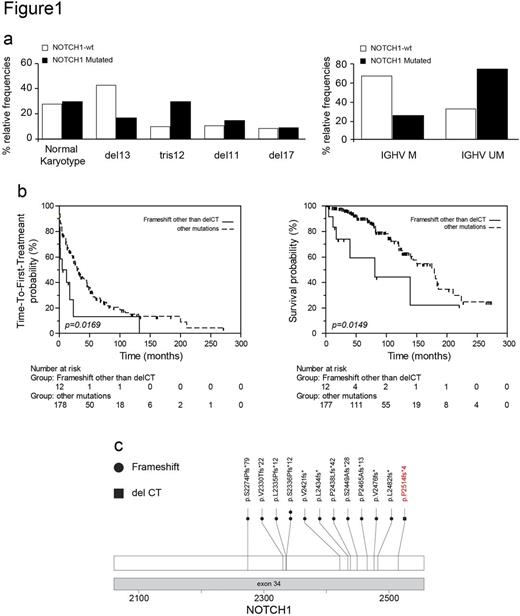Abstract
Background.NOTCH1 mutations have been associated with an aggressive clinical course in chronic lymphocytic leukemia (CLL), and may predict anti-CD20 immunotherapy failure. Although about 80% of NOTCH1 mutations are 2-bp deletions (delCT) causing a sequence frameshift within the PEST domain, other mutations may occur involving either the PEST domain, i.e. frameshift mutations other than delCT (FS), missense (MS) and nonsense (NS) mutations, or, more recently described, the 3'UTR NOTCH1 sequence (UTR).
Aim. To evaluate the clinical impact of the different types of NOTCH1 mutations in terms of time-to-first-treatment (TTFT) and overall survival (OS).
Methods.NOTCH1 mutations were screened in 1003 CLL cases by NGS in exon 34 and part of 3'UTR with at least 1000X coverage and of 1% sensitivity. In selected cases, somatic mutations were confirmed by sequencing of germ line DNA from purified T cells. In our cohort, 529 patients were treated and 151 died. Cytogenetics distribution (n=970) was: 276, normal karyotype; 110, del11; 132, tris12; 369, del13; 83, del17. IGHV gene status (n=891) was: 529, (UM); 362, mutated (M).
Results.
i) Clinical impact of NOTCH1 mutations and correlation with cytogenetics and IGHV gene status. Collectively, NOTCH1 mutations were detected in 190 cases (18.9%): 167 cases bore a single mutation, while 19, 3 and 1 cases bore 2, 3 or 4 mutations, respectively. According to previous studies, cases with NOTCH1 mutations presented a significant shorter TTFT and OS respect to NOTCH1-wild-type (NOTCH1-wt) cases (p<0.0001, and p<0.0001, respectively), and NOTCH1 mutations were more frequent in tris12 CLL cases (p<0.0056) and IGHV UM cases (p<0.0001; Figure1a).
ii) Subclonal analysis of NOTCH1 mutations. Considering the threshold of variant allele frequency of 12% for clonal and subclonal definition, NOTCH1 mutated patients were divided into 118 clonal and 72 subclonal cases. Again in agreement with literature data: a) cases with subclonal NOTCH1 mutations experienced shorter TTFT than NOTCH1-wt cases (p=0.0184), but significantly longer than cases with clonal mutations (p<0.0001); b) no significant difference was observed between cases with subclonal NOTCH1 mutations and NOTCH1-wt in terms of OS (p=0.8246), while statistically significant shorter OS intervals were experienced by cases bearing clonal NOTCH1 mutations (p=0.0001).
iii) Clinical impact of different types of NOTCH1 mutations. The different types of NOTCH1 mutations (delCT, FS, MS, NS, UTR) were evaluated for their putative different prognostic impact in CLL. In order to assign a patient to a given NOTCH1 mutation type, cases presenting more than one mutations were classified using the mutation type presented at the higher percentage. Therefore, the NOTCH1 mutated cases were reclassified as follows: 123 delCT, 12 FS, 8 MS, 17 NS, and 30 UTR. According to Kaplan-Meyer curves, cases belonging to the five categories revealed a significant shorter TTFT respect to NOTCH1-wt cases (delCT p<0.0001; UTR p=0.0001; FS p<0.0001; MS p=0.0274; NS p=0.0108). On the other hand, OS intervals were significantly shorter compared to NOTCH1-wt CLL only in cases bearing delCT or FS mutations (p=0.0003, and p<0.0001, respectively). Notably, when clinical courses of CLL carrying different NOTCH1 mutation types were compared each other, patients carrying FS mutations experienced both shorter TTFT and OS compared to cases belonging to the other mutation groups (p=0.0169, and p=0.0149, respectively; Figura1b). A possible explanation for this phenomenon could be the fact that, in our cohort, FS mutations other than delCT were all located upstream the NOTCH1 region involved in the canonical delCT mutations (Figure1c), allegedly determining a more effective disruption of the PEST domain, and a more pronounced deregulation of NOTCH1 protein.
Conclusion. Our data confirm the capacity of NOTCH1 mutations to predict both TTFT and OS, although subclonal NOTCH1 mutations seem to have a prognostic relevance more for TTFT than OS. Moreover, we demonstrated for the first time that frameshift mutations different from the canonical delCT NOTCH1 mutation predicted for significantly shorter TTFT and OS compared to the other types of NOTCH1 mutations. A screening of NOTCH1 mutations in CLL, also outside the canonical region involved in delCT mutations, is therefore warranted for a correct identification of NOTCH1 mutated cases.
Rossi:Gilead: Honoraria, Research Funding; Abbvie: Honoraria; Janseen: Honoraria. Gaidano:Janssen: Consultancy, Honoraria, Speakers Bureau; Gilead: Consultancy, Honoraria, Speakers Bureau; Novartis: Consultancy, Honoraria, Speakers Bureau; Morphosys: Consultancy, Honoraria; Karyopharm: Consultancy, Honoraria; Roche: Consultancy, Honoraria, Speakers Bureau.
Author notes
Asterisk with author names denotes non-ASH members.


